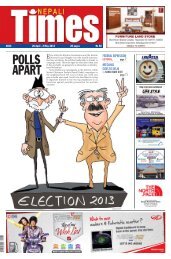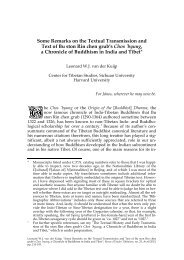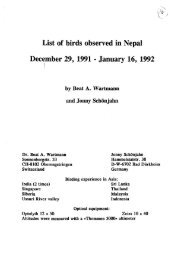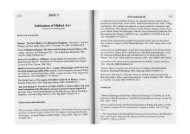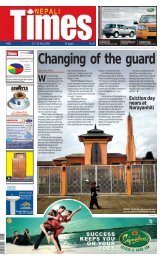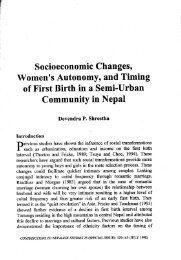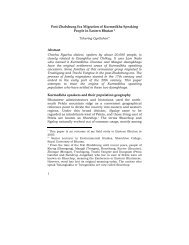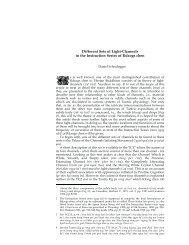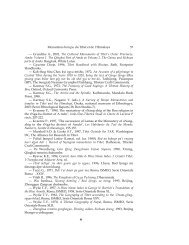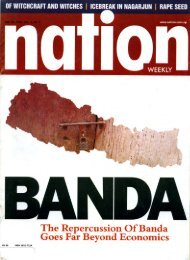Looking at Development and Donors: Essays from Nepal Reviewed ...
Looking at Development and Donors: Essays from Nepal Reviewed ...
Looking at Development and Donors: Essays from Nepal Reviewed ...
You also want an ePaper? Increase the reach of your titles
YUMPU automatically turns print PDFs into web optimized ePapers that Google loves.
192 EBHR-39<br />
<strong>Looking</strong> <strong>at</strong> <strong>Development</strong> <strong>and</strong> <strong>Donors</strong>: <strong>Essays</strong> <strong>from</strong> <strong>Nepal</strong><br />
Devendra Raj P<strong>and</strong>ey (edited by Seira Tamang)<br />
K<strong>at</strong>hm<strong>and</strong>u, Martin Chautari, 2011, 419 pages, ISBN 9789937838924<br />
<strong>Reviewed</strong> by Jeevan Raj Sharma<br />
Foreign aid has been the subject of a gre<strong>at</strong> deal of development rhetoric in<br />
<strong>Nepal</strong>. Although its objectives have rarely been met, foreign aid continues<br />
to shape <strong>Nepal</strong>’s development’s priorities, modalities <strong>and</strong> outcomes.<br />
Currently, around 70 percent of the country’s development expenditure is<br />
financed by external aid <strong>and</strong> this has remained more or less constant for<br />
the last four decades. Clearly, foreign aid has been a key part of <strong>Nepal</strong>’s<br />
development experience, <strong>and</strong> of its successes <strong>and</strong> failures. P<strong>and</strong>ey’s book<br />
documents <strong>and</strong> examines the ‘symmetrical rel<strong>at</strong>ionship’ between the<br />
history of ‘failed’ development <strong>and</strong> foreign aid in <strong>Nepal</strong> <strong>and</strong> is concerned<br />
with fundamental questions: Why has there been very little development<br />
despite six decades of foreign aid? Is foreign aid part of the solution or<br />
part of the problem? P<strong>and</strong>ey’s intellectual position is rooted in his premise<br />
th<strong>at</strong> ‘failed’ development is manifested as rampant poverty, widespread<br />
corruption <strong>and</strong> violent conflict. The book offers a sad <strong>and</strong> ironic picture<br />
of development efforts <strong>and</strong> foreign aid in <strong>Nepal</strong>. The author dem<strong>and</strong>s<br />
accountability <strong>from</strong> donors:<br />
Much of the malaise is the result of ineffectual <strong>Nepal</strong>i institutions<br />
<strong>and</strong> actors … However, given the symmetrical rel<strong>at</strong>ionship between<br />
foreign aid <strong>and</strong> development in <strong>Nepal</strong> <strong>and</strong> the embedded unequal<br />
donor-recipient rel<strong>at</strong>ionship, foreign aid cannot escape scrutiny <strong>and</strong><br />
responsibility for wh<strong>at</strong> has <strong>and</strong> has not happened. (p.11)<br />
Unlike his previous book, provoc<strong>at</strong>ively entitled <strong>Nepal</strong>’s Failed <strong>Development</strong>,<br />
the current volume is a collection of 24 discrete essays on the broadly<br />
defined theme of development <strong>and</strong> donors. Except for Chapter 1, which<br />
was written specifically for this book as a way of providing an overall<br />
framework for the collection, these essays have been published separ<strong>at</strong>ely<br />
over the last three decades as newspaper articles, official present<strong>at</strong>ions<br />
<strong>and</strong> academic writings. The chapters are arranged chronologically under
Book Reviews<br />
193<br />
three headings (‘Panchay<strong>at</strong> Period’, ‘1990 Democr<strong>at</strong>ic Era’ <strong>and</strong> ‘The Year<br />
2000 <strong>and</strong> Beyond’) with a very short six-page introduction by Seira Tamang.<br />
The chronological organis<strong>at</strong>ion of the book not only reflects the distinct<br />
political environments of each period but also global trends in regimes of<br />
foreign aid.<br />
P<strong>and</strong>ey’s writings are not just inform<strong>at</strong>ive but also highly analytical,<br />
with conceptual clarity on a range of topics. The key merit of the book<br />
lies in P<strong>and</strong>ey’s rich historical <strong>and</strong> reflective analysis, thanks to his<br />
background as head of the foreign aid division in 1970s, finance minister<br />
in the first 1990 democr<strong>at</strong>ic cabinet, leading specialist of development <strong>and</strong><br />
leading civil society activist in the last decade or so. As Tamang asserts in<br />
her introduction, ‘Despite, or perhaps because of, the many av<strong>at</strong>ars th<strong>at</strong><br />
the author has taken over this period, the essays display a remarkable<br />
consistency’ (p.1).<br />
P<strong>and</strong>ey’s essays offer critiques of development <strong>and</strong> donors on several<br />
fronts <strong>and</strong> possess a rich potential for further analysis <strong>and</strong> research for<br />
readers interested not only in the history of foreign aid in <strong>Nepal</strong>, but also<br />
for those interested in the theoretical scrutiny of development <strong>and</strong> foreign<br />
aid more widely.<br />
P<strong>and</strong>ey writes, ‘the development partners were able to promote ‘the<br />
dem<strong>and</strong> side’ of the right–based approach to democracy, development <strong>and</strong><br />
development cooper<strong>at</strong>ion’ (p.402). He adds, ‘however, when the “supply<br />
side” is weak, the process cre<strong>at</strong>es a room for conflict’ (p.402). This raises<br />
an important point: Was the Maoist insurgency, which took hold, spread<br />
<strong>and</strong> was ultim<strong>at</strong>ely successful, somehow linked to the n<strong>at</strong>ure of the aid<br />
policies th<strong>at</strong> foreign donors <strong>and</strong> agencies implemented in the country over<br />
the last few decades? More broadly, should we conceptualise the conflict<br />
as a consequence of a perceived ‘development failure’ in <strong>Nepal</strong>? The case<br />
th<strong>at</strong> Peter Uvin argued with respect to the development enterprise in<br />
Rw<strong>and</strong>a (Uvin 1998) may well also be applicable to <strong>Nepal</strong>. In developing<br />
countries such as <strong>Nepal</strong>, where foreign aid provides such a large share of<br />
the financial, technical, ideological <strong>and</strong> human resources of government<br />
<strong>and</strong> civil society, development aid cannot but have played a crucial role in<br />
shaping the processes th<strong>at</strong> contributed to the emergence of the conflict.<br />
P<strong>and</strong>ey raises the issue of the ‘depoliticiz<strong>at</strong>ion’ of development policy<br />
making <strong>and</strong> thus the issue of sovereignty in the context of foreign aid <strong>and</strong><br />
associ<strong>at</strong>ed ‘political’ intentions, dem<strong>and</strong>s <strong>and</strong> conditionalities. He takes
194 EBHR-39<br />
issue with donors’ concern with governance, which has exp<strong>and</strong>ed the<br />
domain of policy making to civil society <strong>and</strong> NGOs. Throughout his writings,<br />
P<strong>and</strong>ey asserts th<strong>at</strong> development is not a technical but r<strong>at</strong>her a political<br />
process, <strong>and</strong> emphasises the importance of ownership <strong>and</strong> accountability<br />
in policy making. He writes,<br />
The corruption-afflicted, misgoverned countries generally need, <strong>and</strong><br />
the donors can always provide, suggestions <strong>and</strong> advice on wh<strong>at</strong> might<br />
be done as remedies … But the donors must be cautious th<strong>at</strong> they do not<br />
design policies <strong>and</strong> programs in such a way th<strong>at</strong> they end up owning<br />
them, releasing the recipient <strong>from</strong> the much needed accountability.<br />
This requires th<strong>at</strong> the advice <strong>and</strong> suggestions do not ‘gradu<strong>at</strong>e’ to<br />
comm<strong>and</strong> <strong>and</strong> conditionalities th<strong>at</strong> become counterproductive. (p.238)<br />
P<strong>and</strong>ey’s writings remind us th<strong>at</strong> an intric<strong>at</strong>e rel<strong>at</strong>ionship exists between<br />
donors <strong>and</strong> the regime in <strong>Nepal</strong>. Not only have foreign donors been a key<br />
tool of political legitimacy for all kinds of regimes <strong>and</strong> governments in the<br />
past, but as Shah (2008) has argued, they have also played an important role<br />
in regime change <strong>and</strong> st<strong>at</strong>e reconstruction in <strong>Nepal</strong> through their funding<br />
<strong>and</strong> influence.<br />
Overall, despite the richness of the inform<strong>at</strong>ion <strong>and</strong> analysis presented<br />
in the book, we are not in a position to answer the question of why foreign<br />
aid continues to be poured into <strong>Nepal</strong> when it has not produced the desired<br />
development outcomes. As post-structuralist scholars of development have<br />
reminded us, r<strong>at</strong>her than taking development failure as self-evident, we<br />
need to ask wh<strong>at</strong> purpose foreign aid has served if not the st<strong>at</strong>ed objectives<br />
of development. For those interested in the st<strong>at</strong>e, has foreign aid with its<br />
discourses on governance <strong>and</strong> corruption had a profound, neg<strong>at</strong>ive impact<br />
on the capacity of the <strong>Nepal</strong>i st<strong>at</strong>e <strong>and</strong> its legitimacy to govern? Let us hope<br />
th<strong>at</strong> P<strong>and</strong>ey or another scholar will interrog<strong>at</strong>e these questions in the future.<br />
References<br />
Shah, S. 2008. Civil Society in Uncivil Places: Soft st<strong>at</strong>e & regime change in <strong>Nepal</strong>.<br />
Washington DC: East West Center, Policy Paper 48.<br />
Uvin, P. 1998. Aiding Violence. The development enterprise in Rw<strong>and</strong>a. West<br />
Hartford: Kumarian Press.




